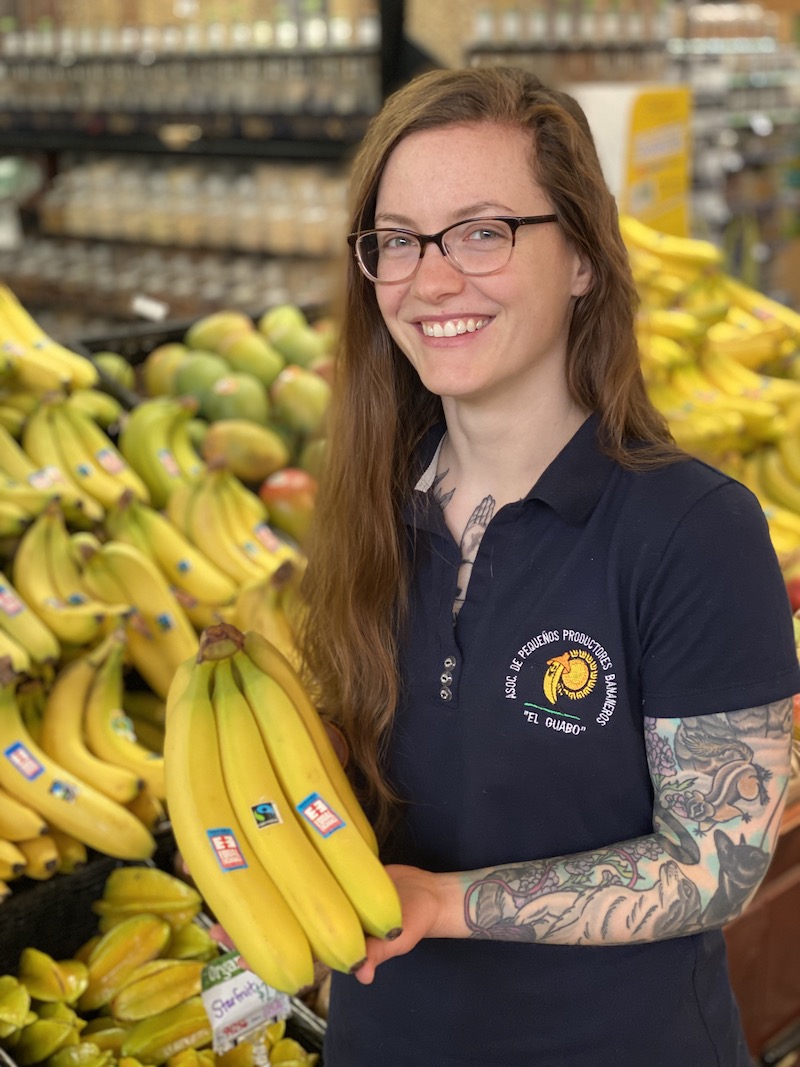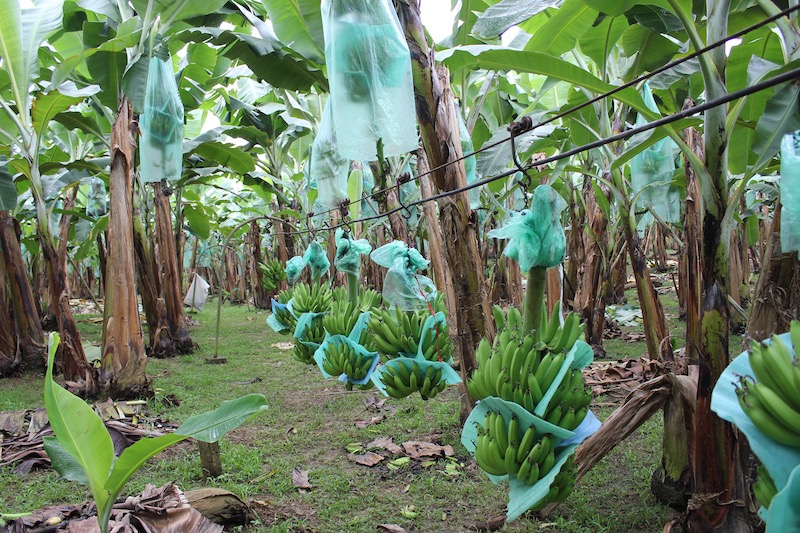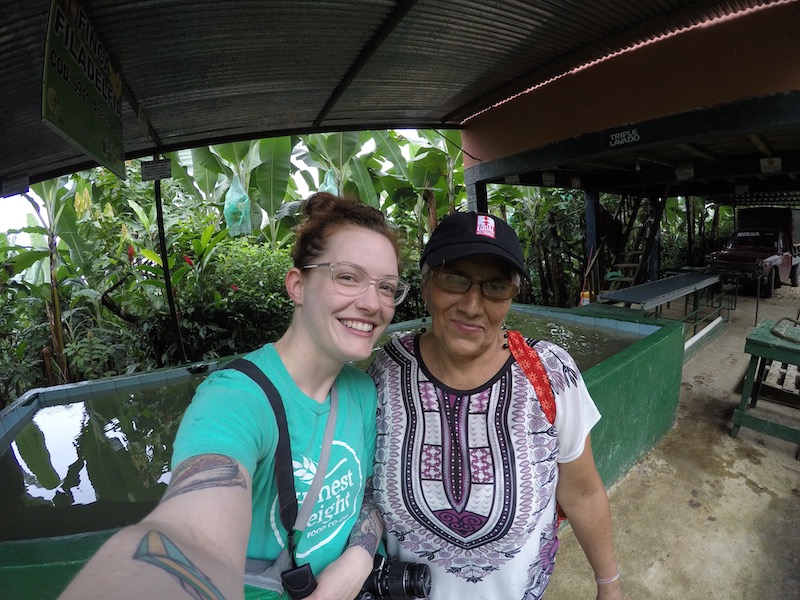Coop Scoop Blog
Honest Weight Visits a Banana Farm Cooperative with Equal Exchange!
By Kate Glenn, Honest Weight's Produce Department Assistant Manager
Photos courtesy of Equal Exchange

This past June I had the privilege to travel with other produce delegates to Ecuador to learn more about where our organic Fair Trade bananas come from. It was an educational experience from farms to port hosted by Equal Exchange and AsoGuabo, the cooperative that organizes 350 small scale banana farms. We also toured some of the community outreach projects that have come from the Fair Trade social premium. Here, I’ll walk you through the whirlwind trip to help illustrate where your food is coming from.
AsoGuabo Cooperative
On our first day, we got a lot of information about AsoGuabo, located in the municipality of El Guabo which is North West of the Province El Oro. It started in 1998 with 14 small-scale banana farmers banding together to send one container (about 38,400 lbs) of bananas to Europe to sell direct to consumer. Today their producers range from the Peruvian border to the south of Guayas province, in which the capital Guayaquil is located. They are the world leader in the export of bananas for the Fair Trade market selling to Agrofair in Europe, Equal Exchange in the USA, All Good in New Zealand and Equifruit/Discovery Organics in Canada. Their average production volume is 35,000 boxes of bananas per week. Fair Trade premiums paid per box contribute to efforts to improve conditions for producers and their communities. Those actions are decided on cooperatively by their 130 members. One of the initiatives we saw on the site of AsoGuabo headquarters was their relatively new program to recycle the plastic bags that bananas are grown inside of to protect from pests. There was also a facility creating bio-ferments to spray on plants to help control the spread of sigatoka negra, a fungus that effects bananas. This introductory day ended in a fun football match that was quite humbling.

The following morning, we headed out to our first farm visit outside of Arenillas, close to the Peruvian border. Out the windows of our bus along the drive were almost exclusively banana fields, peppered with occasional shrimp farms or buildings. The presence of military and police vehicles increased closer to the border. Many of the trucks passing were transporting bananas to shipping containers. One Del Monte truck had rolled off the side of a road, it looked like an unfortunate accident but no one was hurt. When we arrived at the farm we were greeted by the farmer, Eloy. It was technically his father’s land but Eloy does most of the work there now because his father is 89 years old. A lot of the farms will use their families as a means of expansion, but keeping their personal land small. Another producer who was with us on most tours has spread ownership to other members of his family, so collectively the family is a group of small-scale farms. On Eloy’s farm we learned about the process of growing bananas while snacking on pomelos, a large grapefruit-like citrus, that were growing from a tall tree in the middle of the banana field.
Bananas
Bananas are technically an herb, and the fruit is a berry. From the base of the banana plant grows a smaller version, called the daughter, that will replace the plant once it’s finished fruiting. There are usually more than one daughter at a time, most of which are water suckers that the farmers cut away because they will only leech water from the mother. The female flowers appear and that is when one person goes around the farm bagging them to protect them as they grow. They have different colored ties for the bags to label which week of growth they are in. That flower will turn into the “hands” of the bananas then on the end of the stem the male bud forms; it is a purple alien-looking flower. As the hands grow, foam is placed between the layers to protect the bananas from each other. This foam is also something AsoGuabo is working to recycle; the producer of the foam takes back the used pieces from the ones collected at AsoGuabo.
Harvest
The farmers demonstrated for us the process of cutting down the bunch, which involves three people. One person pulls the plant down lower so the bunch can land on the padded surface sitting on the second person’s shoulder. Then the third person cuts the stem so the bunch lands on the second person’s shoulder and then also cuts the whole plant down, leaving a tall stump. The parts cut down are hacked into smaller pieces that become like a compost for the banana plants around them. Meanwhile, the person carrying the banana bunch then walks it over to the cable. Once there are a good number of bunches hanging on the cable that is pulled into the pack house. We were entertained by the efficient young man who pulled the bananas into the pack house and then rode back on the cable by running and jumping on it like a swing, it looked like a lot of fun.
Packing
We traveled to another farm, outside Tillales, after lunch to get a more in-depth tour of a fairly new pack house and inspection process. The banana hands are inspected visually and the flowers on the end are all picked off before it goes into the water because it can contain bacteria that can damage the quality of the fruit. They are rinsed off with a hose for the same reason. The bananas are cut off their stem in large bunches and later trimmed into smaller bunches while in their bath which slowly moves them through with water jets so they are in the water about 3 minutes. When they are pulled out of the bath they are weighed on a tray to the amount that needs to go inside a box. They are misted to help seal their fresh cuts, stickered and packed into a box. We had a little contest to see if anyone could pack the bananas correctly and with speed anywhere near what we had been observing… it’s hard, and there’s a method to it. This all happens in one area which is located on each farm. The pack house we observed had at least ten people doing all of this work throughout the process.
Inspection
Randomly selected boxes are inspected within the pack house when inspectors visit and before being loaded into the shipping container. The inspectors will cut open the banana lengthwise to feel that it is firm and smells like cucumber, not like banana. If it is too soft or smells like banana it will not survive the long journey of exportation. They are also looking for uniformly good-looking fruit. Upon passing any inspection the bananas are loaded onto pallets into trucks at the pack house site and driven to AsoGuabo to be loaded. Together these small farms can fill shipping containers with their pooled resources.
Finca Filadelfia: Agroforestry, Biodiversity, and Slow Food
The following day we toured another farm, this time northeast of El Guabo and at a much higher altitude. This farm, called Finca Filadelfia (after Philadelphia), was an example of the agroforestry program they are working on. The banana growth is slower but it is more biodiverse, allowing for cacao to be produced on the same farm as well as other wild plants. Switzerland has invested in the growth of this program, paying higher premiums for this slow food. We learned a lot about the biodiversity of the farm contributing to the richness of the soil and resistance to disease that attacks the usually homogenous banana farms. This farm was picturesque, way up in a hill and growing throughout the hills. I didn’t even mind too much when I slipped and fell squarely in mud because the farmer, Senora Blanca, wiped the rich soil off my pants with care usually only seen between a parent and their child.
Community Outreach
Later that afternoon (I mentioned this trip was a whirlwind, right?) we visited a couple community outreach projects. The first was a school that had the roof of its outdoor area paid for with premiums from AsoGuabo. It was my first experience being on the other end of a school assembly. The school ranged from kindergarten to high school aged kids. They presented us with food, performed dances and songs for us and thanked us and AsoGuabo for supporting their school. It was absolutely adorable. Then we were fed by a group of women who learned cooking as a business through an entrepreneur class in Tenguel. They also spoke a bit about the brutal history of the widespread labor abuse on banana plantations in the past. The specific history of Tenguel was with United Fruit Company, now known as Chiquita, who ran a large plantation there starting in 1934. In the 1950s there was a fungal infection that destroyed most of the plants and United Fruit laid off hundreds of workers and cut wages of others. In 1962 the workers invaded the plantation and seized the land, United Fruit Company abandoned the area but Ecuador didn’t fully recover from this until the mid-1970s. Today in contrast to other Latin American banana producing countries the three largest banana corporations, Chiquita, Dole and Del Monte still don’t own a significant stretch of land in Ecuador. But they do operate on a lot of the land. The cooking group fed us a good meal and an entire table full of different desserts made from bananas.
Puerto Bolivar - Shipping
Our final tour destination was Puerto Bolivar where the bananas in their shipping containers are loaded onto ships. The port has been owned by Yilport Holdings, Inc. since 2016 which is from Turkey. They are working on expanding that port with an aggressive 10-30 year plan to become the largest terminal on the west coast of Latin America. The inspection rate for items leaving this port was high, at ten percent. The biggest take away from this stop was the volume of conventional bananas in comparison to the organic and Fair Trade that leave from the port. Bananas are not the only products passing through this port but it is a large amount of their business.
Thank you!
I hope this gives you a glimpse into the lives of all the people in Ecuador working every day to get bananas all over the world. The scale of production seems massive even at the level of the small-scale farmers and to think that’s a fraction of the bananas that are produced and eaten throughout the world is amazing to me. Every person I met while there was so welcoming and warm and those working are passionate about what they do. I am so thankful I had the opportunity to see it firsthand.

